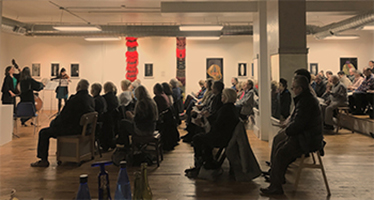by David Kulma

This concert was a sequel of sorts. Back in September a group of musicians played quintets that added piano or double bass to a string quartet core. This time, the same ensemble — violinists Masha Andreini and Mari Sato, violist Yael Sanemaud-Cohen, cellist Anna Bowman Hurt, bassist Tracy Rowell, and pianist Elizabeth DeMio — returned for quintets by Louise Farrenc and Robert Schumann.
Born a year after Berlioz, Farrenc should be better known as a composer. Her Piano Quintet No. 1 from 1840 is an excellent piece of music. Written in a well-crafted early Romantic style with elaborate piano lines — Farrenc was a piano professor at the Paris Conservatory for three decades — it has the flavor of a Chopinesque etude. The inclusion of the double bass gives the work a deep hue, and Andreini, Sanemaud-Cohen, Hurt, Rowell, and DeMio brought off this delightful score with ample polish.
The first movement is delightfully conventional — DeMio handled the constant passagework with ease — while the second is sensitive in its grace. The compact and sprightly scherzo was the highlight, and the surprisingly chromatic finale deserved the excellent rendition it received.
Schumann’s Op. 44 is at the center of the piano quintet repertoire. It’s hard to believe someone could write something so remarkable in just a few weeks. The beauty of this work was immediately apparent as Andreini, Sato, Sanemaud-Cohen, Hurt, and DeMio dug into the opening bars. The thickets of melodies and constant interplay is the perfect vehicle for what could be considered classical musicians’ special sauce — full vibrato, carefully calibrated rubato, and continuously impassioned playing.
The first movement achieved surprising power as the players followed their tempo impulses. The funereal slow movement with its dark deceptive motions was a deep meditation. The ever-scalar scherzo was imposing in its rhythmic precision and forward drive, while the finale brought this musical gem to an apt close.
To round out an engaging evening, all six musicians returned together to play a punchy encore: the exuberantly minor-key “Waltz” from Aram Khachaturian’s Masquerade.
Published on ClevelandClassical.com February 17, 2020.
Click here for a printable copy of this article


